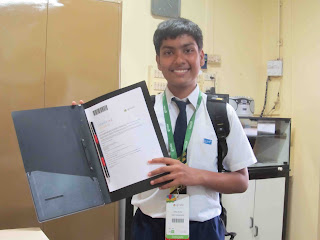The GreenLine effect
The week
following the last session (for the scholastic year) of the GreenLine team with the students
and coordinating staff, one of the student representatives, Atharva Chaturvedi spoke
at the school assembly. He outlined the
initiatives and the projects for the school.
Here is his address:
 ·
After the enlightening session given by the
Green line team, the students who attended the meeting were made aware about
the threats to the various animals in India, the reasons for their extinction
and the steps needed to conserve them.
·
After the enlightening session given by the
Green line team, the students who attended the meeting were made aware about
the threats to the various animals in India, the reasons for their extinction
and the steps needed to conserve them.
·
As a part of our task we would be working on an
activity called the ‘Project Sparrow’.
The objective of this activity is
to reuse waste material such as used plastic bottles and tetra packs to make
bird feeders to support local sparrow population as we are aware that the
number of sparrows is dwindling. The
leaders would be visiting the classrooms to speak to the students the
procedures to go about this project.
- · The Green line team was really happy with the response that they received from you all during the last edition of the Green Runner Magazine based on the theme 'Fauna of Mumbai.' We hope that you continue with better and more informative articles on relevant issues in the future.
The 2nd of February, every year is
observed as world Wetland Day. It is a
day where actions aimed at spreading public awareness about role and importance
of wetlands are carried out. That's why the
February issue of Green Runner Magazine will be all about: 'The wonders of our
wetlands.'
Remember: Wetlands include
marshes, creeks, seasonal or unseasonal water bodies and most importantly -
Mangroves.
The Green line team is looking for:
Ø
Original write ups / articles / poems / facts
that you'd like to share o the topic.
Ø
Original artwork related to the conservation of
wetlands and mangroves.
Ø
Any information that you have related to the
flora and fauna of wetland areas in Mumbai.
Ø
Reports of activities that you have carried out
in the school or nature trips that you have been on.
Ø
Interesting nature photographs that you have
taken.
Ø
Feedback on the previous issues and on the
sessions.
Ø
You can send your entries to: newsletter.greeline@gmail.com
Thanks
GreenLine. A ripple effect indeed!
























.jpg)
.jpg)